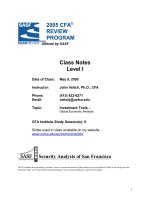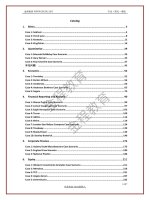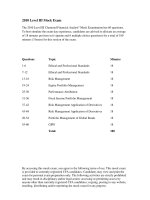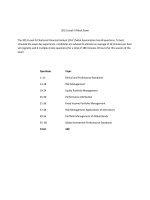CFA CFA level 3 study NotéCFA level 3 CFA level 3 CFA level 3 CFA level 3 finquiz item set questions, study session 17, reading 33
Bạn đang xem bản rút gọn của tài liệu. Xem và tải ngay bản đầy đủ của tài liệu tại đây (36.14 KB, 7 trang )
Reading 33
Evaluating Portfolio Performance
FinQuiz.com
FinQuiz.com
CFA Level III Item-set - Question
Study Session 17
June 2018
Copyright © 2010-2018. FinQuiz.com. All rights reserved. Copying, reproduction or
redistribution of this material is strictly prohibited.
FinQuiz.com © 2018 - All rights reserved.
Reading 33
Evaluating Portfolio Performance
FinQuiz.com
FinQuiz Item-set ID: 8546
Questions 1(8547) through 6(8552) relate to Reading 33
Leslie Wilson Case Scenario
Leslie Wilson maintains a website where he likes to post his articles. His articles have featured
various topic areas including organizational issues, finance and investment management.
Wilson is currently working on an article related to managerial performance appraisals and
manager continuation policies. He feels he has never touched this subject before and needs to
give it greater emphasis. He has only prepared the introduction of the article. The remainder of
his article is in draft form. An excerpt of the article is provided below.
The Need for a Manager Continuation Policy (MCP)
It takes many years for an investment manager to generate extraordinary performance. If you
break their track record up, you’ll notice that a good chunk of the superior returns is dispersed
over several years.
What does this imply? The solution to this question may be quite dreadful. If a manager’s past
performance is used as a benchmark, the manager’s job may be in jeopardy. If I link this dreadful
course of action to the statement made in the first paragraph, I wouldn’t be wrong to conclude
that there is a high likelihood of superior managers underperforming and subsequently being
fired over a short time frame.
There are also other drawbacks associated with frequent manager firings, which I have listed
below:
1) waste of a sponsor’s time and expense
2) although there is no need for portfolio liquidation, a fired manager’s portfolio needs to be
converted when moving the portfolio to a manager who possesses a different investment
style.
The problems associated with manager firings have stressed the need for a manager continuation
policy.
The Purpose of a MCP
There are several purposes of a MCP, which are discussed further in the article.
The MCP Process
The MCP process consists of two components:
1) Manager Monitoring
2) Manager Review
FinQuiz.com © 2018 - All rights reserved.
Reading 33
Evaluating Portfolio Performance
FinQuiz.com
These components are discussed below.
Manager Monitoring
I.
II.
III.
IV.
The goal of this process is to identify any potential signs of danger in the manager’s
organization.
It is a formal process that helps to provide data on the manager’s operations.
As part of the manager monitoring process, the sponsor receives certain information.
The results of this process are used to remove inferior managers (underperforming over a
long period of time) and retain the superior managers (outperforming over a long period
of time).
Manager Review
I.
II.
III.
IV.
V.
This process will follow manager monitoring.
If the monitoring process identifies warning signs, a manager review becomes essential.
The review process is quite different from the manager selection process.
In contrast to the monitoring process, the review process involves making decisions
regarding retaining or firing managers. The criteria for conducting this process are
independent from the hiring process.
There are namely three criteria used when making the firing/retention decision.
FinQuiz Question ID: 8547
1. The drawbacks highlighted by Wilson, in his article are most likely:
A. correct.
B. incorrect with respect to drawback 1.
C. incorrect with respect to drawback 2.
FinQuiz Question ID: 8548
2. The purposes of a MCP, which Leslie refers to, least likely include:
A. to maximize managerial turnover.
B. to give emphasis to non-performance data in the evaluation process.
C. to develop consistent organizational policies and procedures.
FinQuiz Question ID: 8549
3. In the context of the Manager Monitoring section, which of the points listed is/are least likely
correct?
A. I and II.
B. I and IV.
C. IV only.
FinQuiz.com © 2018 - All rights reserved.
Reading 33
Evaluating Portfolio Performance
FinQuiz.com
FinQuiz Question ID: 8550
4. The ‘certain information’ Leslie refers to within point III of the Manager Monitoring section
least likely includes:
A. operational matters
B. a discussion of the manager’s investment strategies on a retrospective and prospective
basis.
C. a discussion of the manager’s investment strategies on a retrospective basis only.
FinQuiz Question ID: 8551
5. In the context of the Manager Review section, which of the points listed is/are most likely
incorrect?
A. II only.
B. III and IV only.
C. II, III and IV.
FinQuiz Question ID: 8552
6. The ‘three criteria’ Leslie refers to within point V of the Manager Review section, least likely
include:
A. a cost and benefit analysis.
B. an analysis of the fundamental changes in the manager’s operations.
C. an analysis of the manager’s skills.
FinQuiz.com © 2018 - All rights reserved.
Reading 33
Evaluating Portfolio Performance
FinQuiz.com
FinQuiz Item-set ID: 8177
Questions 7(8178) through 12(8183) relate to Reading 33
Cremitia Associates Case Scenario
Doug Owen, CFA develops testing material for CFA Program candidates. The material is
published in print form and sold internationally.
He is currently developing questions for the Level III candidates pertaining to benchmarks –
their types, qualities, benefits and drawbacks. He has created a table, provided below, with some
missing entries. Candidates are responsible for answering questions pertaining to the table.
Benchmark Type
a)
Description
Benefits
This can be illustrated Conceptually simple
through a minimum
return objective, which
a pension fund must
meet to fund
retirement liabilities.
b) Manager Universes The fund sponsor
selects a median
manager from the
broad universe of
available managers or
funds.
Measurable
c) Factor-ModelBased
By capturing the
systematic sources of
returns, they help
managers and sponsors
better understand the
manager’s investment
style.
d)
Managers will use
Possesses all required
research to select the
properties of
best investment
benchmark.
opportunities and
construct a benchmark
by weighting those
identified
opportunities.
e)
These indices
hypothetically lead to
Users will be able to
comprehend these
FinQuiz.com © 2018 - All rights reserved.
Drawbacks
Does not possess the
properties of a
legitimate benchmark.
It can be ambiguous as
it is possible to
construct one or more
benchmarks with the
same exposure but
earning different
returns.
Constituent securities
and sectors may
Reading 33
Evaluating Portfolio Performance
segmenting a portfolio indices with little
into various styles to
difficulty.
create a suitable match
between the portfolio
and the index.
f) Broad Market
Indices
Popular indices, such
as the S&P 500 and
Wilshire 5000, are
used as benchmarks.
FinQuiz.com
possess undesirably
large allocations.
There is a possible
conflict of the
manager’s actual
investment style and
the style implied by
the benchmark.
Unambiguous,
specified in advance
and investable.
FinQuiz Question ID: 8178
7. Benchmark type ‘A’ most likely is:
A. manager universes.
B. broad market indices.
C. an absolute benchmark.
FinQuiz Question ID: 8179
8. The drawbacks of using manager universes as a benchmark least likely include:
A. the median account may only be established on an ex ante basis.
B. different accounts will represent the median account across evaluation periods.
C. they are subject to survivorship bias.
FinQuiz Question ID: 8180
9. The most appropriate description for a Factor-Based Model is:
A. it establishes a relationship between portfolio and market index return.
B. it relates the beta on a security or portfolio to the return on the market index.
C. the return of security is expressed as a non linear function of the return on a broad market
index.
FinQuiz.com © 2018 - All rights reserved.
Reading 33
Evaluating Portfolio Performance
FinQuiz.com
FinQuiz Question ID: 8181
10. The benchmark type and drawback most appropriate for ‘D’ is:
A. Returns-based benchmark. A drawback of this benchmark is that it may hold certain
securities and sectors which the manager may find unacceptable.
B. Custom-security based benchmark. A drawback of this benchmark is that a majority of
these indices are unpublished resulting in a lack of transparency.
C. Custom-security based benchmark. A drawback of this benchmark is that it will be
difficult for some investment managers to monitor and control the investment process
due to a lack of benchmark transparency.
FinQuiz Question ID: 8182
11. Benchmark type ‘E’ most likely is:
A. a returns-based benchmark.
B. factor-based benchmark.
C. a style Index.
FinQuiz Question ID: 8183
12. A drawback of a broad market index most likely includes:
A. a conflict of styles between the manager and the benchmark.
B. expensive to obtain.
C. difficult to obtain.
FinQuiz.com © 2018 - All rights reserved.









